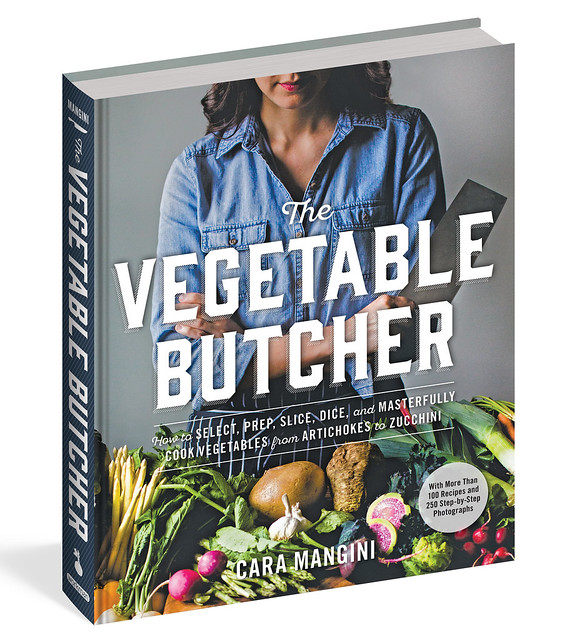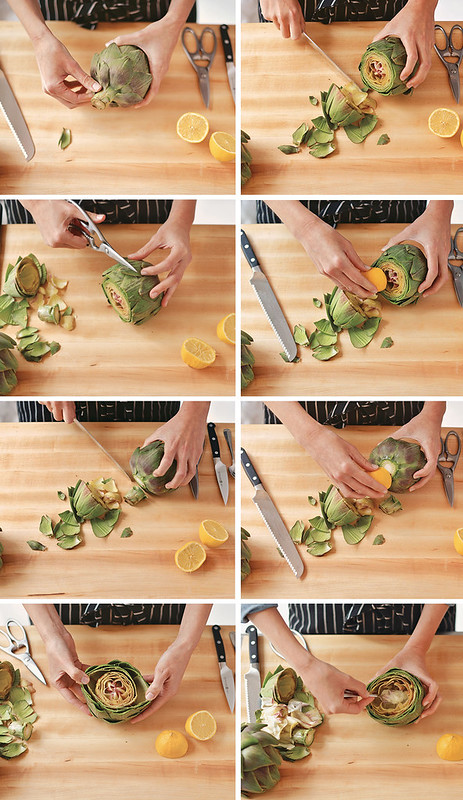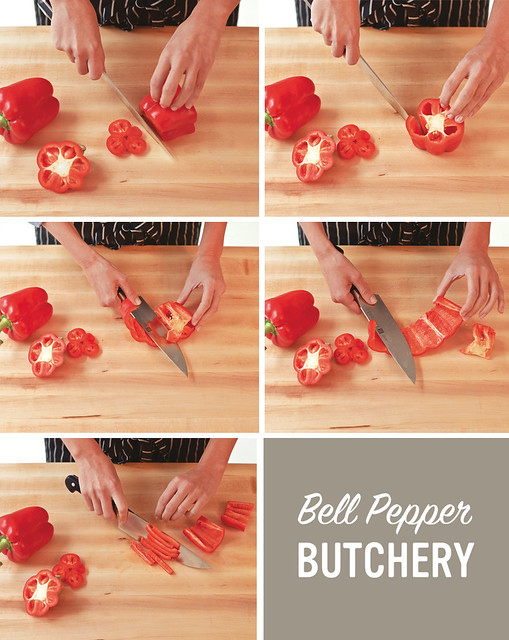“The Vegetable Butcher is a butchery bible and vegetable boot camp all in one. If you ever wanted to know how to slaughter a squash or eviscerate an eggplant, here's where you start.”
— Amanda Cohen, chef and owner of Dirt Candy
To say we are excited about The Vegetable Butcher, a new book by chef Cara Mangini, would be a gross understatement. We receive so many questions from our members about the proper way to handle, prep and clean fruits and vegetables, that this book is becoming our go-to directory for tackling the tough produce prep questions. There are step-by-step, color photographs on how to chiffonade kale, break down winter squash, cut cauliflower into steaks and so much more.
Photograph of Cara Mangini by Matthew Benson.
Cara Mangini comes from a long line of butchers. Her Italian grandfather and great-grandfather gracefully cut tenderloins and butterflied chickens for a living. Mangini also wields a knife, but hers is used against the curves of butternut squash and the stalks of freshly picked Brussels sprouts at Little Eater, her vegetable-inspired restaurant, produce stand, and artisanal foods boutique in Columbus, Ohio.
Mangini has created a complete vegetable education with The Vegetable Butcher. Not only does the book demystify the preparation of vegetables and present essential knife skills, it also includes everything you need to know to select, store, and cook fresh vegetables.
Below, we have included a sneak peek into the book to illustrate some of the helpful tips, photos and even recipes that are included.
Artichoke Butchery: Prepping the Whole Artichoke
With its spiky leaves and tightly formed head, the flower bud of an artichoke appears impenetrable, perhaps inedible. True – we must trim the artichoke thorn-tipped leaves and remove its fuzzy choke, but the toothsome leaves and sweet, tender heart hiding within are worth the fuss. Once this prep work becomes routine, there are countless ways to enjoy this harbinger of spring.
Photography by Matthew Benson
2) Use a serrated knife to cut off the top one quarter to one third, removing the prickly tips.
3) Snip off the remaining tips, working your way around the artichoke.
4) Rub the cuts with lemon.
5) Use a serrated or chef’s knife to cut the stem flush with the base so the artichoke can sit upright.
6) Rub the cut with lemon.
7) If stuffing the artichoke, force apart the leaves to reveal the center.
8) Use a spoon (ideally a grapefruit spoon) to dig into the center, pull out the inner thorny leaves, and scrape away the fuzzy choke.
9) Place the prepared artichokes in the acidulated water until ready to use.
If you’re looking for a simple artichoke recipe, make sure to check out our Steamed Artichoke with Taragon Butter.
Bell Pepper Butchery: Cutting Bell and Other Round Peppers
Photography by Mathew Benson
1) Using a chef’s knife, cut off the top of the pepper, just where the stem meets the body. Cut off the bottom of the pepper, reaching no higher than the indented middle of the pepper’s base.
2) Place the pepper upright on one of its flat ends. Make a vertical slit down one side of the pepper.
3) Place the pepper on its side, skin side down. Position your knife’s blade parallel to your board and cut around the pepper’s core, cutting through the ribs to release the core. Unroll the pepper and discard the core.
4) Place the flat sheet of pepper skin side down against your board and go back through it to remove any remaining seeds and ribs. Alternatively, keep the pepper upright and use a paring knife to make vertical cuts to remove each side of flesh around the core, rotating the pepper as you make the cuts. Place the slices flat against your board and cut out the ribs and seeds.
5) Now you can cut the flat pepper into thin strips to your desired thickness or gather the strips and cut them to produce dice. You can trim the end of the pepper and cut it, too. (I find it easiest to cut against the inside of the flesh, not against the more slick skin.)
Marinated Basil and Garlic Peppers on Goat Cheese Tartines
Photograph by Mathew Benson
We're so happy to announce we have a copy of this amazing book to give away to one of you!
–Here's How to Enter –
To win a copy of The Vegetable Butcher, simply leave a
comment answering the question below by Wednesday, June 7th, 2017 before 1:00pm (one entry per
person please).
If you could ask Cara to share her insider's knowledge about one particular produce item, what would it be and why?
No purchase required. Limit one entry per person, please.
Entries will close on Wednesday, June 7, 2017. Winners are chosen by Random
Number Generator and announced on our blog on Wednesday, June 7, 2017.
THIS CONTEST IS NOW CLOSED.
Thank you to everyone who participated!
Our winner is Michele who wrote:
KALE! There are so many different varieties and types! I love it in restaurants and salad bars, but every time I get it in my shipment and try to make something...epic fail! Would love some recipes and prep tips. THANKS! it!"




